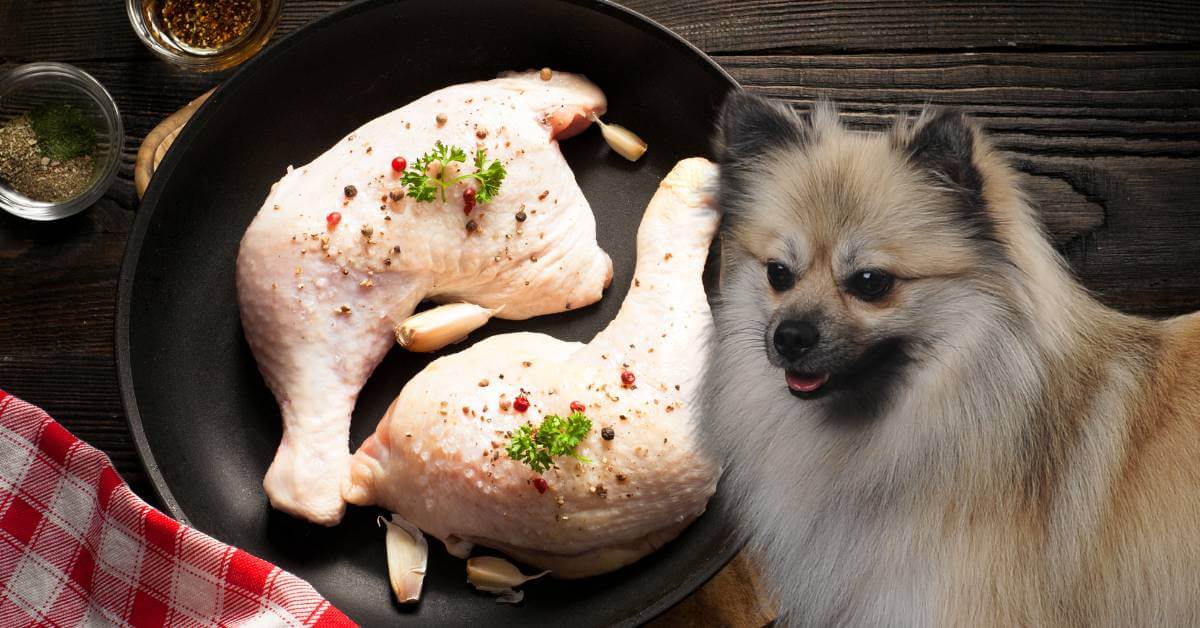Can Dogs Eat Chicken Thighs and Drumsticks?
Yes, dogs can eat chicken thighs, but there are a few things to remember. Deboned, oven-baked, or boiled chicken thighs, chicken legs, or drumsticks without spices are a safe and tasty option for your dog. If you want to spoil your dog, try adding some carrots for a gourmet meal they’ll love! Just make sure to avoid any seasonings to keep your dog healthy and happy.

Can dogs eat raw chicken thighs and raw bones?
Dogs shouldn’t eat raw chicken thighs, chicken legs, or raw bones. While dark chicken meat is nutritious, feeding it raw to your dog can be risky. Raw chicken can harbor harmful bacteria like Salmonella and E. coli, which can cause severe gastrointestinal issues for your dog. Additionally, raw meat can carry parasites that might affect your dog’s health. It’s best to cook chicken thighs thoroughly to eliminate these risks and ensure your dog gets a safe, nutritious meal. This goes for any chicken meat for dogs!
Raw bones are a bit different. Raw bones are generally safer than cooked ones because they are less likely to splinter and cause internal injuries. However, raw chicken thigh bones are still not recommended. There’s a choking hazard risk, and bones can cause blockages in your dog’s digestive tract. Even though they might not splinter like cooked bones, they can still be too hard for your dog to chew safely, leading to dental damage or other health problems. So, it’s better to avoid giving your dog raw chicken thigh bones altogether.
Why do people even consider feeding their dogs raw meat?
Many dog owners consider feeding their pets raw meat because they believe it’s more natural and closer to what dogs’ wild ancestors, like wolves, would eat. The idea is that raw diets might provide better nutrition and health benefits compared to conventional dog food. Since wolves have a limited capacity to digest carbohydrates, some people think their dogs should also avoid carb-heavy diets.
However, domestic dogs have evolved significantly from their wild ancestors. They have a greater ability to digest starches thanks to genetic changes, so their dietary needs differ from those of wolves. Studies have shown that domestic dogs have a different balance between energy and nutrient needs, and they tend to live longer than their wild counterparts. In fact, experts in feeding zoo-kept canids, including wolves, often recommend conventional processed dog food for better health and longevity.
Some small studies have hinted at potential benefits of raw feeding, like higher fecal bacterial diversity and better stool quality. However, these studies are limited, and the health implications are still unclear. So, while the idea of raw feeding might seem appealing for its natural roots, it’s essential to consider the modern dog’s evolved needs and the safety of their diet.
Cooked chicken thighs and their benefits for dogs
When prepared properly, cooked chicken thighs, chicken legs, or drumsticks can be a delicious and nutritious addition to your dog’s diet. Unlike raw chicken, cooked chicken thighs eliminate the risks of harmful bacteria and parasites. They also provide essential nutrients that can help keep your dog healthy and happy. Let’s look at some of the main benefits of feeding your dog cooked chicken thighs.
In conclusion, while the idea of feeding dogs raw meat might seem appealing for its natural origins, it’s important to consider the evolved dietary needs and safety concerns for modern domestic dogs. Cooked chicken thighs, prepared without bones or spices, offer a safer and nutritious alternative. We hope this article helps you make informed decisions about your dog’s diet.
Love, life, and fur forever!
FAQs
How many chicken thighs for a dog?
The number of chicken thighs a dog can eat depends on their size and dietary needs. Generally, chicken should make up no more than 10% of your dog’s daily caloric intake. One chicken thigh is sufficient for a small dog, while a larger dog can eat two. Always consult with your veterinarian to determine the right portion size for your dog.
Can dogs eat chicken thighs for an upset stomach?
Yes, dogs can eat plain, cooked chicken thighs for an upset stomach. Boiled chicken thighs without bones, skin, or spices are gentle on the digestive system and can help soothe an upset stomach. Pairing the chicken with plain, cooked rice can further aid in digestion and recovery.